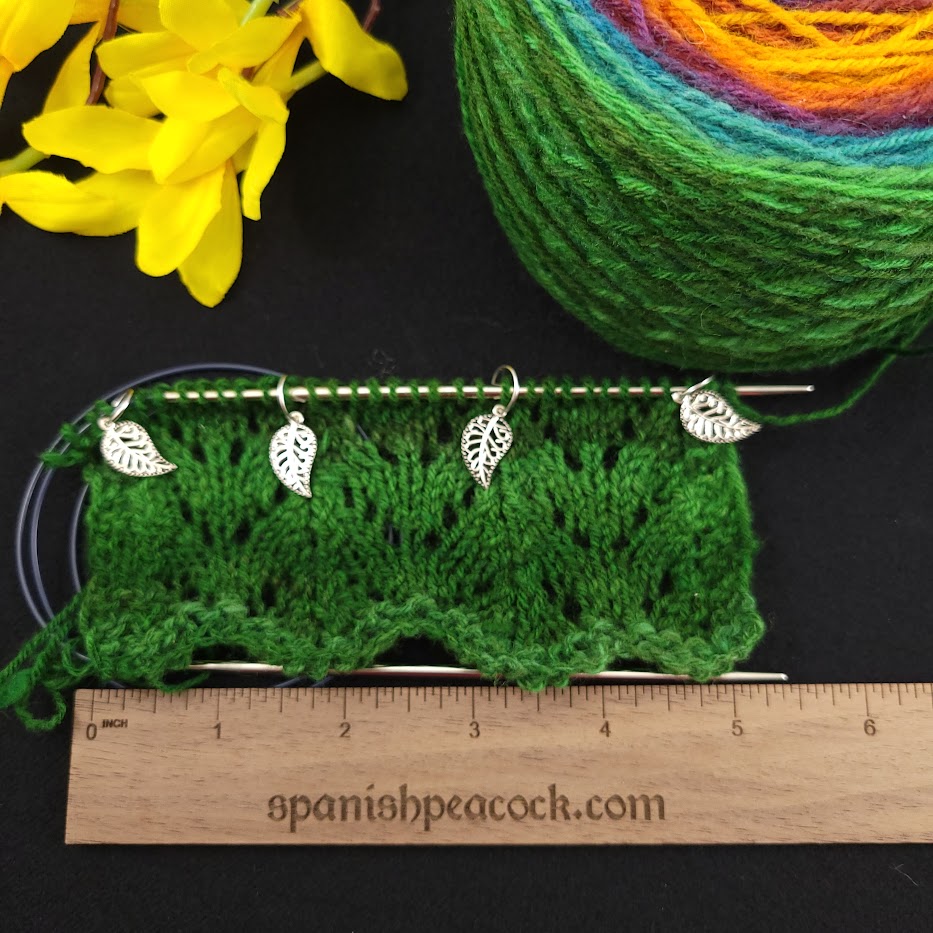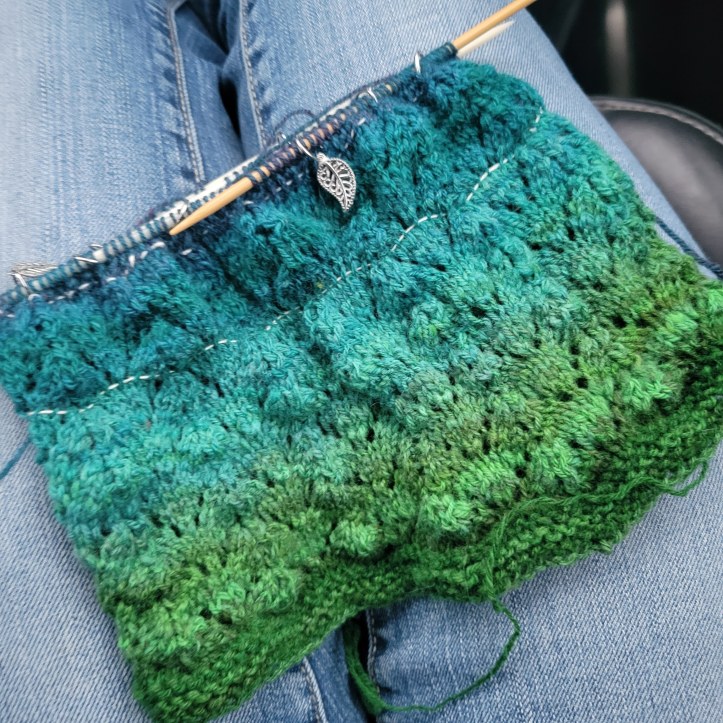Friends, I have come to terms with a harsh reality: I am a terrible knitter.
I’m also a fan of self-help books, and the ones I’ve read offer two different perspectives on how to deal with your weaknesses. One camp says, “Build up your strengths to the point where your weaknesses become irrelevant.” Which sounds good, but doesn’t help me use up my ever-growing stash of handspun yarn.
The opposite approach: find ways to compensate for your weaknesses. Which makes more sense to me. In case it helps anyone else, here is a list of tricks I’m am currently using to compensate for my knitting fails.
And if you were wondering, no, I am not a new knitter. I cast on for the first time over 13 years ago. I’m just…bad at knitting.
SWATCHING
I don’t typically waste time on swatches, but if your garment needs a particular fit, the time investment is worth it. The cowl pattern I am knitting is meant to be tight enough to double as a hat, which can only be accomplished with the correct gauge. My first swatch with size five needles was WAY off, so I’m glad I checked. Size three needles got me in the range I was looking for.
The pattern instructions weren’t entirely clear (to me, anyway) on how to knit the swatch. Here is the approach I used:
- CO 33 stitches
- knit three rows in garter
- Begin pattern: garter stitch 3, repeat baby fern pattern three times, garter stitch 3
- 36 rows for the swatch would be 3 garter, 5 repeats of baby fern, 3 garter

Lazy knitter tip: I only knit a large enough swatch to ensure I was close-ish on the width. Since I was knitting with handspun, I used one end of the same skein of yarn I would knit the actual cowl from. Then I frogged the sample, and re-cast on with the frogged yarn. I probably should have knit the full swatch and blocked it and everything, but I wanted to use every last yard of yarn for the cowl itself.
Context
I have amazing friends who can knit anywhere, any time. Even at movie theaters, in pitch dark.
I’m the exact opposite.
I cannot knit while watching, well, anything. The moment my eyes stray from my needles, all sorts of mayhem ensues. I miss yarn overs. My stitch from the previous row stays on the needle along with the new stitch causing unintended increases. I drop stitches. I forget to count my pattern repeats and end up with a hot mess as a result.
In fact, I can barely carry on a conversation while knitting. Sometimes really good audiobooks spell my doom. If I’m not concentrating on each stitch, I’m just better off, well, not knitting!
Now that I realize this about myself, I don’t even try to knit when the context doesn’t support it. Watching TV with family, chatting with friends—these are times when I fall back to spinning, even if it means I’m not making progress with my cowl.
As a result, knitting the cowl is taking FOREVER. But it would take even longer if I were constantly frogging my mistakes, so I persevere.
Chart rather than written instructions
I learned the hard way with Angelique that I read lace charts more easily than written instructions.
I was driven to create my own chart because I was unable to find one online, presumably because the lace design is so simple most designers didn’t see a need for one. Thanks to the magic of Stitch Fiddle, I was able to draft a chart for the Baby Fern lace pattern very easily.
Overkill for such a simple lace? Probably. Still remarkably helpful for me? Yes, absolutely.

Here’s the chart, just in case anyone else out there needs it!
One DPN of a different material
OK, I didn’t intend to invent a knitting hack for myself.
As it turns out, the pattern calls for a 16″ circular needle. Guess who didn’t have a circular needle that short? Me, apparently! But I had plenty of double pointed needles. Plus this gave me an excuse to use my favorite Spanish Peacock-made giraffe bone needles. (He was a pet at a personal zoo, if you were wondering. The giraffe. Not the Peacock.)
Then I realized the number of baby lace fern repeats did not divide evenly by four.
One needle needed to be longer than the others to carry the extra nine stitches. I added one longer bamboo needle alongside the three bone ones. Turns out this substitution was sheer brilliance.
I never have to wonder where the next row starts.

Previously I would have used a different stitch marker the start of the next row, but with DPNs that stitch marker will slide off unless you set it in one stitch. Well. I’m knitting a lace pattern. Every other row starts with k2tog, which means that stitch maker would have ended up being VERY inconvenient. Now it doesn’t matter. When I hit the bamboo needle, it’s the next row. No extra stitch maker to fiddle with.
Stitch markers plus counting for every pattern repeat
The actual baby fern lace pattern repeats over “just” nine stitches. Who can’t keep track of nine stitches of lace pattern at a time? Me, apparently!
Breaking each row into sets of nine helps me catch mistakes sooner. And there have been a lot of mistakes. My Achilles heel appears to be a yarn over right before a slip slip knit. I have finally figured out I need to be on the lookout for these missed yarn overs.

Unfortunately knowing that the mistakes happen doesn’t stop me from making them. I just catch them sooner because I only have to count to nine to find the mistake.
Lifelines. Lots of lifelines.
Lifelines are extra threads placed regularly in your knitting so if you have to frog to a previous point, or if you drop a stitch, you have a hard stop and a secure place to pick up again. Who had to frog at least once and is grateful she had lifelines?
Yep, me!
In the middle of one round, I forgot what I was doing and started knitting an even row (just knit) rather than the odd one I was supposed to be knitting (lace pattern).
Naturally, I didn’t realize the issue until another row later.
Luckily I was only two rows from my previous lifeline, and it was easier to just frog to the lifeline and restart than attempt to tink back far enough to fix my mistake.
I started the cowl with lifelines every twelve rows, or two completed pattern repeats. (See the DPN photo above.) After having to use one I switched to every six rows. (See the stitch marker photo.) Yes it seems tedious, but it REALLY saves time when, well, you’re a horrible knitter! You can read additional tips about lifelines here.
Did I Miss Anything?
What other tips or tricks do you suggest for improving knitting results when you’re just not a good knitter? Share your ideas in the comments!

Great tips! I’m still a learning knitter. It was just before I took up supported spindles that I knit my first non rectangular object. The Pierre shawl from Westknits. I learned my lesson with counting and markers! Haven’t tried any charts yet. But the way I kept track reading the pattern, was post-its.
Since the sticky notes can eventually damage printer toner, I slip the pattern into a sheet protector, and use the post-its on that. I can make notes, or count as I complete each step or repeat I’m counting so if I put it down, I know exactly where I left off. There are different size post-it pads, as well as tabs and strips that are very handy.
LikeLike
It sounds like you’re actually an excellent knitter, now that you’ve figured out that you need peace and quiet! Would a terrible knitter have come up with their own knitting hack?! I think not.
Really enjoyed this post and have had many of the same challenges myself, so reassuring to see others forgetting yarn overs!
LikeLike
[…] I also found a loose stitch during the drive. Despite all my tips and tricks to help keep my knitting progress on track, a SSK ended up just … loose. I somehow missed it until after the cowl was completely […]
LikeLike